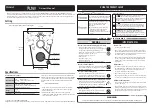
5-92 Curve Fit Commands
SR785 Dynamic Signal Analyzer
EGAN (?) i {,x}
The EGAN command sets (queries) the gain for one of the curve tables. The
parameter i selects curve table 1 (0) or curve table 2 (1) The parameter x is the
gain value.
ETRC (?) i {,j}
The ETRC command sets (queries) the trace associated with one of the curve
tables. The parameter i selects curve table 1 (0) or curve table 2 (1) The
parameter j is the trace number, from 1 to 5.
EITM ? i ,j
The EITM command sets queries the number of items associated with a specific
table format for one of the curve tables. The parameter i selects curve table 1 (0)
or curve table 2 (1) The parameter j selects the type of item as Zeros (0), Poles
(1), Residues (2), Numerator Polynomial (3), or Denominator Polynomial (4).
This command will switch the table format to the specified representation
beforing return the number of items.
EPLY(?) i, j, k {,x}
The EPLY command sets (queries) the polynomial coefficients for one of the
curve tables. The parameter i selects curve table 1 (0) or curve table 2 (1). The
parameter j selects the numerator polynomial (1), or the denominator polynomial
(0). The parameter k selects which polynomial coeffiecient will be set (queried.)
from 0 up to the number of items in the list. The parameter x is the actual
coefficient.
This command will change the specified table format to polynomial.
EPOL(?) i, j {,x [,y]}
The EPOL command sets (queries) the poles for one of the curve tables. The
parameter i selects curve table 1 (0) or curve table 2 (1). The parameter j selects
which pole will be set (queried.) from 0 up to the number of items in the list. The
parameter x is the real part of the pole. The optional parameter y is the imaginary
part (if any) of the pole
This command will change the specified table format to pole/zero.
EZER(?) i, j {,x [,y]}
The EZER command sets (queries) the zeros for one of the curve tables. The
parameter i selects curve table 1 (0) or curve table 2 (1). The parameter j selects
which zero will be set (queried.) from 0 up to the number of items in the list. The
parameter x is the real part of the zero. The optional parameter y is the imaginary
part (if any) of the zero
This command will change the specified table format to pole/zero.
ERES(?) i, j {,x [,y]}
The ERES command sets (queries) the residues for one of the curve tables. The
parameter i selects curve table 1 (0) or curve table 2 (1). The parameter j selects
which residue will be set (queried.) from 0 up to the number of items in the list.
Содержание SR785
Страница 4: ...ii ...
Страница 10: ...viii ...
Страница 80: ...1 64 Exceedance Statistics ...
Страница 158: ...2 78 Curve Fitting and Synthesis SR785 Dynamic Signal Analyzer ...
Страница 536: ...5 136 Example Program SR785 Dynamic Signal Analyzer ...
















































